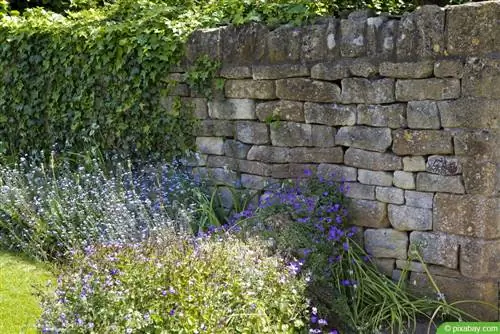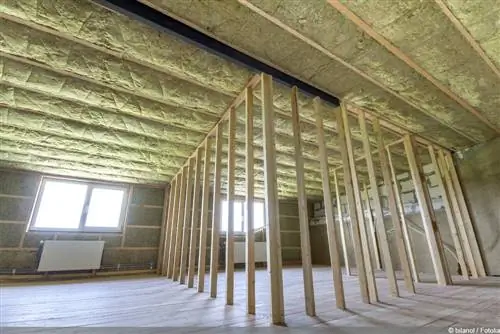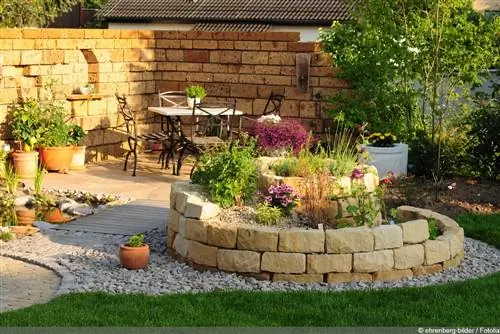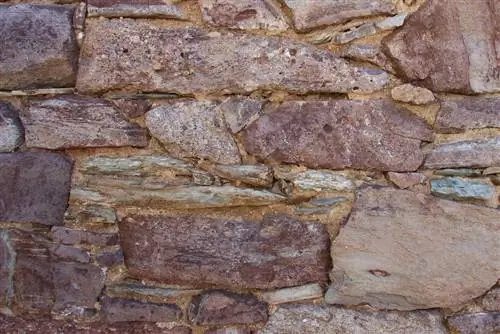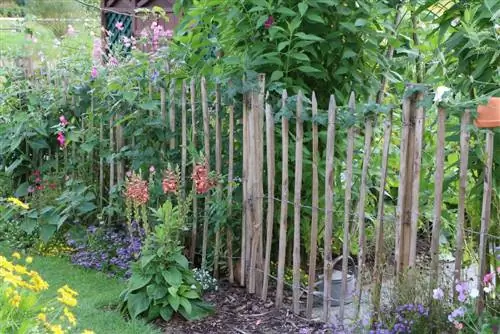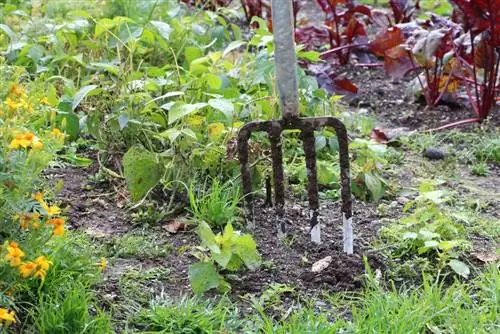- Author admin [email protected].
- Public 2023-12-17 03:39.
- Last modified 2025-01-24 12:45.
Garden walls made of rustic bricks have a very special charm. But not every garden owner is blessed with such a property boundary. Gray, clunky concrete walls detract from the look and give off a dreary appearance. The gardener would prefer to hide the masonry. Not a bad idea at all. Because to cover a desolate garden wall, only a few materials and hardly any craftsmanship are required. These x options will help do-it-yourselfers who are looking for creative wall cladding.
Covering the garden wall with natural stone
A clad garden wall made of natural stone makes a lot of impression because at first glance you can't tell that it's just a narrow layer of the high-quality material. The do-it-yourselfer applies this approximately 2 to 3 cm thick. The following natural stones are ideal for cladding.
Note:
When cladding with natural stone, the focus is on an elegant look. A rustic appearance is undesirable with this style. It is therefore important that the do-it-yourselfer applies the coating very evenly to avoid later unevenness.
In general, natural stones are very expensive. There are significant price fluctuations among the different types. The large selection not only offers the customer the opportunity to choose a fairly affordable stone, but also allows it to be visually adapted to the rest of the garden design. Below are the advantages and disadvantages as well as the suitability of the different types of rock:
Granite
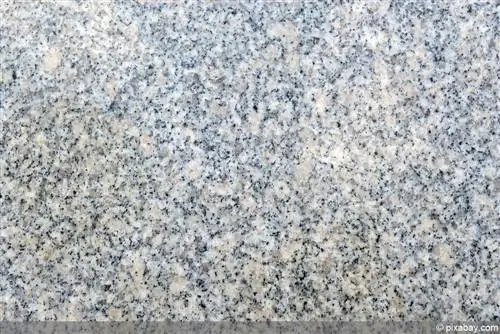
Although the disadvantages outweigh the disadvantages in the list above, granite is well suited for wall cladding due to its extreme hardness. In addition, the natural stone has a beautiful shine that DIY enthusiasts can renew again and again by simply polishing it up. With this property, granite fits perfectly into modern, elegant gardens.
Advantages
- unbeatable hardness
- very durable
- weather-resistant
- can withstand strong temperature fluctuations
Disadvantages
- high weight
- vulnerable to frost
- not resistant to penetrating moisture
- not fireproof
- very expensive
- prone to scratch marks
Quartz Stone
Quartz stone has a homogeneous, fine-pored structure and can therefore be ideally ground into shape. At the same time, this property also ensures high abrasion. With its metallic gray shine, quartz stone looks very elegant and is a cheap alternative to expensive granite in modern gardens.
Advantages
- velvety surface with a shiny feel
- works well
- suits block steps and steles
- widely frost resistant
- sure-footed
Disadvantages
- prone to scratches
- high risk of wear
Tip:
Bright granite or quartz stone create a Mediterranean look.
Marble
Many people are more familiar with marble from interior design, for example as a window sill or kitchen unit. Just as the shiny natural stone looks elegant indoors, it also creates a high-quality look as a garden wall. Marble harmonizes very well with noble plants such as roses.
Advantages
- attractive shades and countless color variations
- waterproof
- easy to clean
Disadvantages
- requires regular polishing
- expensive
- acid sensitive
Slate
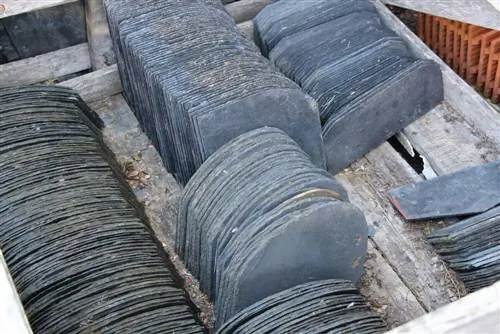
The dark, anthracite-colored slate has a slight shimmer. Many people associate the material with high standards. Slate harmonizes particularly well with elements made of concrete, metal or glass.
Advantages
- weather-resistant
- looks classy
- good cleavage
- water-repellent
Disadvantages
- prone to corrosion
- prone to scratches
Tip:
In order to maintain the shine, the do-it-yourselfer should rub his slate wall regularly with linseed oil.
Green garden wall
If you want to save yourself work and costs, go for the natural look and add greenery to your garden wall. It doesn't necessarily have to be the classic ivy. Nurseries and specialist shops offer numerous, sometimes exotic, plants that feel at home on a wall. The only disadvantages of this method are the pruning required depending on the plant choice and the time it takes to grow an opaque wall.
Planting a hedge
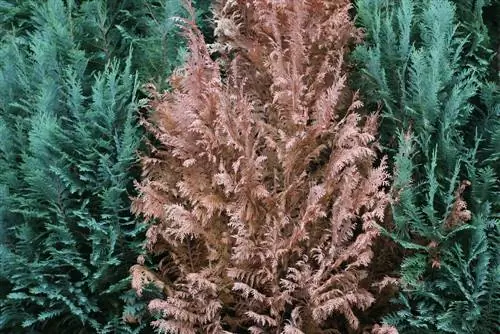
Particularly unstable garden walls that are unlikely to be able to withstand heavy vegetation, it is a good idea to plant a hedge on both sides. The plants already have a certain height (unless the do-it-yourselfer grows his plants himself), so the latter disadvantage no longer applies.
Suitable plants include:
- Yew (Taxus)
- Thuja (Thuja)
- Cypress (Chamaecyparis)
- Privet (Ligustrum)
- Holly (Ilex)
- Cotoneaster (Photinia)
- Boxwood (Buxus)
- Common beech (Fagus sylvatica)
Tip:
To loosen up the garden hedge, it is recommended to plant a tree or colorful blooming flowers in isolated places.
Let the wall grow
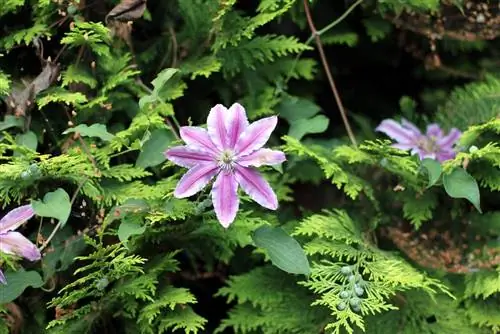
Creating a wall provides variety, especially in rock gardens. It is important to ensure that the plants can tolerate drought and do not “eat” into the rock. The do-it-yourselfer should also take the location requirements (sunny or shady) into account.
Here is a small selection of worthwhile climbing plants:
- Climbing roses (pink)
- Climbing hydrangea (Hydrangea petiolaris)
- Clematis
- Wisteria (Wisteria)
- Trumpet Flower (Campsis)
- Wine (Vitis vinifera)
Planting joints
A third option that requires a little more effort is to expand the joints. The do-it-yourselfer then fills these with humus soil and allows green plants to grow out of them. Ferns are very suitable for this variant.
Covering the garden wall with wood
With wooden cladding, the unsightly rock garden wall can be transformed into a natural wooden fence in no time. The design options here are very diverse. Whether vertical or horizontal, delicate or rustic. These types of wood are particularly suitable, the advantages and disadvantages of which are shown below:
Douglas fir (Pseudotsuga menziesii)
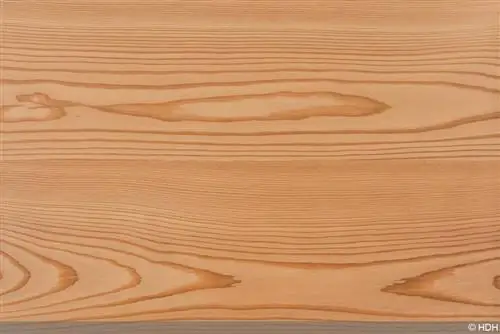
Advantages
- good stamina
- weather-resistant
- resistant to fungi
- good strength and elasticity properties
Disadvantages
light, reddish wood darkens quickly
Oak (Quercus)
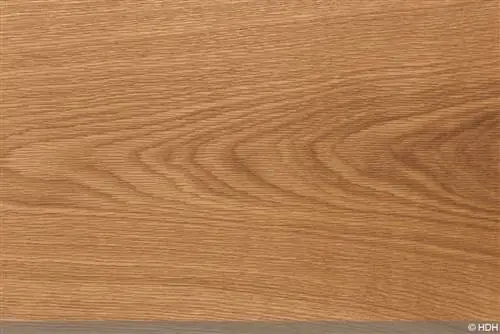
Advantages
- many color nuances
- optionally with grain
- good elasticity
- easy to split
- water-repellent
- durable
Disadvantages
- heavy and hard
- darkens quickly
Note: Grayish oak indicates high hardness.
Tropical wood
Tropical woods include species such as teak, bangkirai, meranti, ebony and bongossi.
Advantages
- attractive grain
- durable
Disadvantages
- environmentally harmful extraction methods
- susceptible to fungal diseases
- expensive
Larch (Larix)
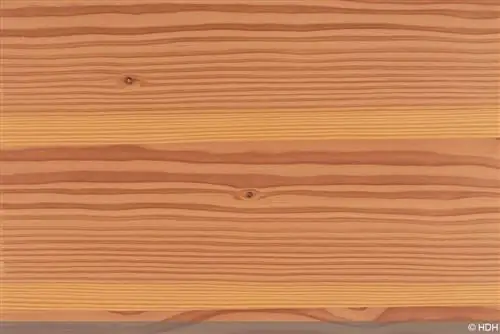
Advantages
- acid-resistant
- pleasant resin smell
- low risk of cracking
- resistant to insects and fungi
Disadvantages
- Resin removal is required before staining or painting
- darkens quickly
- Quality differences depending on origin
Wood processing
In order to attach the wooden cladding, it is first necessary to screw stable wooden panels to the stone wall as supporting elements. The choice of orientation (vertical or horizontal) should depend on the weather side.
Covering the garden wall with bamboo
One of the easiest methods is to get bamboo mats from the hardware store and attach them to the garden wall. Even for several meters, the do-it-yourselfer only pays a small amount of money. The look exudes an Asian flair. However, the do-it-yourselfer has to replace the bamboo mats after a few years as wind and precipitation wear out the material.
Note:
If you want to save money, you can also get plastic imitations from hardware stores that can be attached to the garden wall in just a few simple steps. Although most of these products look deceptively real from a distance, closer inspection ultimately reveals that they are fake. Anyone who chooses this variant should definitely pay attention to high-quality workmanship. Otherwise the cladding will quickly look cheap. Expensive plastic also has a hefty purchase price.

